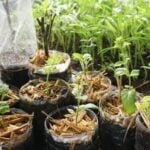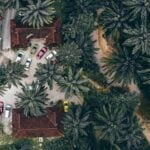When it comes to protecting vegetable gardens in Canada from pests and diseases, insect netting is a crucial tool for gardeners. Insect netting acts as a physical barrier, preventing insects and pests from damaging plants while also reducing the risk of diseases spreading. This article will explore the different types of insect netting available, how to choose the right netting for specific vegetables and the Canadian climate, as well as provide tips on installation, maintenance, and care.
Insect netting serves as an effective method for organic pest control in vegetable gardens in Canada. It offers a non-toxic solution that reduces the need for chemical pesticides while promoting healthier plant growth and improving overall crop yield. With the increasing emphasis on sustainable gardening practices, insect netting has become an essential element in maintaining a successful vegetable garden.
Throughout this article, readers will gain valuable insight into the benefits of using insect netting, learn how to select the appropriate type for their garden’s needs, and discover reputable suppliers in Canada where they can purchase high-quality insect netting. Whether you are a novice or experienced gardener, incorporating insect netting into your gardening routine can lead to bountiful harvests and greater peace of mind knowing your plants are protected.
Types of Insect Netting
When it comes to protecting vegetable gardens in Canada from pests and diseases, choosing the right insect netting is crucial. There are various types of insect netting available, each with different mesh sizes, materials, and levels of durability. The type of netting you select will depend on the specific needs of your garden and the climate in Canada.
One popular type of insect netting for vegetable gardens in Canada is the fine mesh variety. This type of netting has a small mesh size that effectively keeps out smaller pests such as aphids and thrips. The fine mesh also provides excellent protection against insects carrying plant diseases, helping to prevent the spread of infections among your vegetable plants.
Another common type of insect netting for Canadian vegetable gardens is made from durable materials such as polyethylene or nylon. These materials are strong and long-lasting, providing reliable protection for your plants throughout the growing season. When selecting insect netting based on materials, it’s important to consider factors such as UV resistance and tear strength to ensure that the netting can withstand the harsh Canadian climate.
In addition to fine mesh and durable materials, there are other considerations to keep in mind when choosing the right insect netting for your vegetable garden in Canada. Factors like air circulation and sunlight penetration are essential for healthy plant growth.
Some types of netting may hinder these vital elements if not chosen carefully. For this reason, it’s important to select a type of insect netting that strikes a balance between pest protection and optimal growing conditions for your vegetable plants.
| Type | Characteristics |
|---|---|
| Fine Mesh Netting | Small mesh size effective against smaller pests; prevents spread of infections |
| Durable Material Netting (Polyethylene or Nylon) | Strong and long-lasting; good UV resistance; high tear strength; can withstand harsh Canadian climate |
| Air Circulation & Sunlight Penetration Considerations | Balance between pest protection and optimal growing conditions for vegetables is crucial |
Choosing the Right Netting for Your Garden
When it comes to selecting the right insect netting for your vegetable garden in Canada, there are several factors to consider to ensure optimal plant protection while allowing for proper air circulation and sunlight penetration. Different vegetable plants may require different types of netting, and the climate in Canada can vary significantly depending on the region. Here are some essential tips for choosing the best insect netting for your garden.
Consider Mesh Size and Material
One of the first considerations when selecting insect netting for your vegetable garden is the mesh size. The mesh size will determine what type of pests are kept out while still allowing beneficial insects access to your plants. In addition, considering the material of the netting is crucial as it will affect durability and lifespan. Most insect nettings are made of materials such as polyethylene or polyester, each with its own advantages and disadvantages.
Account for Climate Variations
The climate in Canada can vary greatly from region to region, so it’s important to choose an insect netting that is suitable for your specific climate conditions. In colder regions, you may need a heavier-duty netting to provide additional protection against frost and snow, while in warmer regions, a lighter netting may be sufficient. It’s also important to consider moisture levels and potential wind damage when selecting insect netting for Canadian gardens.
Balance Air Circulation and Sunlight Penetration
While protecting your plants from pests is crucial, it’s equally important to ensure they have proper air circulation and sunlight penetration. When choosing insect netting, look for options that allow for adequate airflow while still providing shade to prevent excessive heat buildup. Strike a balance between pest protection and creating a healthy growing environment for your vegetable plants.
By considering these factors when choosing insect netting for your vegetable garden in Canada, you can select the best option for your specific needs, ensuring healthy plant growth while keeping pests at bay.
Installation
Installing insect netting in your vegetable garden is crucial to protecting your plants from pesky pests and harmful diseases. Proper installation ensures that the netting effectively covers your crops while allowing sunlight and air circulation. Here’s a step-by-step guide on how to install insect netting in your vegetable garden to ensure optimal protection for your plants.
Gather Your Materials
Before you begin, make sure you have all the necessary materials on hand. This may include insect netting, supports such as hoops or stakes, zip ties, or clips for securing the netting, and any tools required for installation.
Measure and Cut the Netting
Measure the area of your garden that needs to be covered by the insect netting. Once you have the measurements, carefully cut the netting to the appropriate size, leaving some extra material to allow for proper coverage and securing.
Set Up Supports
Depending on the type of vegetable plants in your garden, you may need to set up supports such as hoops or stakes to hold the insect netting in place. Ensure that these supports are sturdy and properly positioned for maximum coverage.
Secure the Netting
Using zip ties or clips, secure the edges of the insect netting to the supports, ensuring that there are no gaps where pests could enter. Be sure not to pull too tight so as not to damage the netting but tight enough for it to stay in place.
Ensure Proper Coverage
Once secured, double-check that the insect netting adequately covers all of your vegetable plants without any openings or gaps. This step is crucial in ensuring that pests are effectively kept out while still allowing essential air circulation and sunlight penetration.
By following these simple steps, you can successfully install insect netting in your vegetable garden, providing vital protection for your crops against common pests and diseases while promoting healthy plant growth and improving overall crop yield.
Maintenance and Care
In order to ensure the longevity and effectiveness of insect netting for vegetable gardens in Canada, proper maintenance and care are essential. One key aspect of maintenance is regular cleaning of the netting to remove any dirt, debris, or pollen that may have accumulated.
This can be done by rinsing the netting with water or gently scrubbing it with a soft brush. It’s important to avoid using harsh chemicals or abrasive cleaning tools as they can damage the netting material.
Another important aspect of maintenance is repairing any damages that may have occurred to the netting. This includes patching up holes or tears to prevent pests from gaining access to your plants. Small rips can be easily repaired with patches made from the same materials as the netting. For larger damages, it may be necessary to replace sections of the netting altogether.
Finally, storing insect netting properly during the off-season is crucial to ensure its longevity. When not in use, the netting should be cleaned, thoroughly dried, and stored in a cool, dry place away from direct sunlight. This will help prevent mold and mildew growth and prolong the lifespan of the netting.
Overall, proper maintenance and care for insect netting for vegetable gardens in Canada are essential for ensuring its effectiveness in protecting plants from pests while also extending its lifespan for long-term use.
| Maintenance Tips | Care Advice |
|---|---|
| Regularly clean the netting with water or a soft brush | Avoid using harsh chemicals or abrasive tools |
| Repair any damages such as holes or tears | Properly store the netting during off-season in a cool, dry place away from sunlight |
Benefits of Using Insect Netting
Insect netting for vegetable gardens in Canada offers numerous benefits that can significantly improve the health and yield of your plants, while also reducing the need for chemical pesticides. Here are some key advantages of using insect netting in your garden:
- Reduction of Pest Infestation: Insect netting forms a physical barrier that effectively prevents pests such as aphids, caterpillars, and beetles from damaging your vegetable plants. By keeping these harmful insects at bay, you can minimize the risk of pest infestations and the subsequent damage to your crops.
- Promotion of Healthier Plant Growth: Insect netting not only protects your plants from pests but also creates an ideal environment for their growth. The physical barrier helps to maintain a controlled climate around the plants, ensuring that they receive adequate sunlight, water, and nutrients without being compromised by pests or harsh weather conditions.
- Improvement in Overall Crop Yield: With the protection provided by insect netting, your vegetable plants can thrive and produce bountiful yields. By safeguarding them from pest damage and diseases, you are more likely to experience a higher crop yield, leading to a more successful harvest at the end of the growing season.
Moreover, using insect netting in your vegetable garden aligns with organic gardening practices and promotes sustainable agriculture. By reducing reliance on chemical pesticides, you are contributing to a healthier ecosystem and minimizing potential harm to beneficial insects and wildlife. Additionally, this method can lead to cost savings in the long run as you won’t need to invest as much in chemical pest control products.
Recommended Suppliers
In conclusion, insect netting for vegetable gardens in Canada is an essential tool for protecting your plants from pests and diseases while promoting healthier growth and improved crop yield. With a variety of types available, including different mesh sizes and materials, gardeners can choose the right netting for their specific vegetable plants and the climate in Canada. By installing insect netting properly and maintaining it regularly, gardeners can enjoy the benefits of reduced pesticide use and overall better plant health.
When it comes to purchasing high-quality insect netting in Canada, there are several reputable suppliers that offer a range of options to meet your gardening needs. From durable mesh netting to lightweight and breathable materials, these suppliers have everything you need to protect your vegetable garden from unwanted insects. Whether you’re looking for economical solutions or specialty netting for specific plants, these suppliers have you covered.
With the information provided in this article, Canadian gardeners can confidently select and install the right insect netting for their vegetable gardens. By choosing the best netting for their specific needs, they can effectively protect their plants while also reducing the need for harmful chemical pesticides. Insect netting not only supports healthier plant growth but also contributes to a bountiful harvest at the end of the season.
Frequently Asked Questions
What Is the Best Insect Netting for Vegetables?
The best insect netting for vegetables is typically a fine mesh material that can effectively keep pests out while allowing sunlight, water, and air to reach the plants. Look for durable and UV-protected netting to ensure long-lasting protection.
What Is the Best Netting for Vegetable Gardens?
When it comes to choosing the best netting for vegetable gardens, it’s important to consider the size of the mesh, the material’s durability, and its ability to provide adequate protection against insects. Many gardeners prefer lightweight and breathable netting that is easy to install over their vegetable beds.
What Vegetables Need Insect Netting?
Certain vegetables are more susceptible to insect damage than others and may benefit from the use of insect netting. Crops such as cabbage, broccoli, cauliflower, kale, and carrots are commonly protected with netting to prevent pests like aphids, cabbage worms, and carrot flies from damaging the plants.

If you’re looking to get into vegetable gardening, or are just looking for some tips on how to make your current garden better, then you’ve come to the right place! My name is Ethel and I have been gardening for years. In this blog, I’m going to share with you some of my best tips on how to create a successful vegetable garden.





